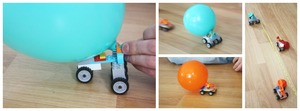Learning Domain: Algorithms & Programming
Standard: Debug (identify and fix) errors in an algorithm or program that includes sequences and simple loops.
Degree of Alignment:
Not Rated
(0 users)
MITECS.A4-7.CT
Michigan Integrated Technology Competencies for Students
Grades PK-2
Learning Domain: Computational Thinker
Standard: Students develop and employ strategies for understanding and solving problems in ways that leverage the power of technological methods to develop and test solutions.
Degree of Alignment:
Not Rated
(0 users)
Learning Domain: Writing
Standard: Participate in shared research and writing projects (e.g., read a number of books on a single topic to produce a report; record science observations).
Degree of Alignment:
Not Rated
(0 users)
Learning Domain: Writing
Standard: Recall information from experiences or gather information from provided sources to answer a question.
Degree of Alignment:
Not Rated
(0 users)
Learning Domain: Measurement and Data
Standard: Measure the length of an object by selecting and using appropriate tools such as rulers, yardsticks, meter sticks, and measuring tapes.
Degree of Alignment:
Not Rated
(0 users)
Learning Domain: Measurement and Data
Standard: Measure to determine how much longer one object is than another, expressing the length difference in terms of a standard length unit.
Degree of Alignment:
Not Rated
(0 users)
Learning Domain: Measurement and Data
Standard: Use addition and subtraction within 100 to solve word problems involving lengths that are given in the same units, e.g., by using drawings (such as drawings of rulers) and equations with a symbol for the unknown number to represent the problem.
Degree of Alignment:
Not Rated
(0 users)
Learning Domain: Measurement and Data
Standard: Generate measurement data by measuring lengths of several objects to the nearest whole unit, or by making repeated measurements of the same object. Show the measurements by making a line plot, where the horizontal scale is marked off in whole-number units.
Degree of Alignment:
Not Rated
(0 users)
Learning Domain: Measurement and Data
Standard: Generate measurement data by measuring lengths using rulers marked with halves and fourths of an inch. Show the data by making a line plot, where the horizontal scale is marked off in appropriate units—whole numbers, halves, or quarters.
Degree of Alignment:
Not Rated
(0 users)
Learning Domain: Geometry
Standard: Solve problems involving scale drawings of geometric figures, including computing actual lengths and areas from a scale drawing and reproducing a scale drawing at a different scale.
Degree of Alignment:
Not Rated
(0 users)
Learning Domain: Statistics and Probability
Standard: Approximate the probability of a chance event by collecting data on the chance process that produces it and observing its long-run relative frequency, and predict the approximate relative frequency given the probability. For example, when rolling a number cube 600 times, predict that a 3 or 6 would be rolled roughly 200 times, but probably not exactly 200 times.
Degree of Alignment:
Not Rated
(0 users)
Learning Domain: Mathematical Practices
Standard: Model with mathematics. Mathematically proficient students can apply the mathematics they know to solve problems arising in everyday life, society, and the workplace. In early grades, this might be as simple as writing an addition equation to describe a situation. In middle grades, a student might apply proportional reasoning to plan a school event or analyze a problem in the community. By high school, a student might use geometry to solve a design problem or use a function to describe how one quantity of interest depends on another. Mathematically proficient students who can apply what they know are comfortable making assumptions and approximations to simplify a complicated situation, realizing that these may need revision later. They are able to identify important quantities in a practical situation and map their relationships using such tools as diagrams, two-way tables, graphs, flowcharts and formulas. They can analyze those relationships mathematically to draw conclusions. They routinely interpret their mathematical results in the context of the situation and reflect on whether the results make sense, possibly improving the model if it has not served its purpose.
Degree of Alignment:
Not Rated
(0 users)
Learning Domain: Mathematical Practices
Standard: Use appropriate tools strategically. Mathematically proficient students consider the available tools when solving a mathematical problem. These tools might include pencil and paper, concrete models, a ruler, a protractor, a calculator, a spreadsheet, a computer algebra system, a statistical package, or dynamic geometry software. Proficient students are sufficiently familiar with tools appropriate for their grade or course to make sound decisions about when each of these tools might be helpful, recognizing both the insight to be gained and their limitations. For example, mathematically proficient high school students analyze graphs of functions and solutions generated using a graphing calculator. They detect possible errors by strategically using estimation and other mathematical knowledge. When making mathematical models, they know that technology can enable them to visualize the results of varying assumptions, explore consequences, and compare predictions with data. Mathematically proficient students at various grade levels are able to identify relevant external mathematical resources, such as digital content located on a website, and use them to pose or solve problems. They are able to use technological tools to explore and deepen their understanding of concepts.
Degree of Alignment:
Not Rated
(0 users)
Standard: Analyze data from tests to determine similarities and differences among several design solutions to identify the best characteristics of each that can be combined into a new solution to better meet the criteria for success.
Degree of Alignment:
Not Rated
(0 users)
Standard: Develop a model to generate data for iterative testing and modification of a proposed object, tool, or process such that an optimal design can be achieved.
Degree of Alignment:
Not Rated
(0 users)



Comments